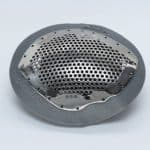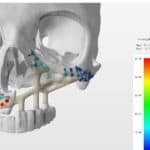On July 20-21, the cellular agriculture research institute New Harvest had their annual conference at the MIT Media Lab in Cambridge, Massachusetts. 3DHEALS Community Manager for Boston, Jess Charlap, attended the conference to investigate the overlap between 3D printing for healthcare, especially bio-printing, and cellular agriculture, also known as lab-grown meat.
What is New Harvest?
Established in 2004, New Harvest supports research that reinvents the way we make animal products. By applying advances in tissue engineering and synthetic biology to growing food, New Harvest plans to revolutionize the supply chain of animal products to continue to provide affordable and sustainable food to a growing population. They call this “cellular agriculture.”
Cellular agriculture can produce eggs, milk, meat, and more without intensive crop and animal farming. Unfortunately, this nascent field is not well supported by existing research funding mechanisms. New Harvest encourages innovation inn cellular agriculture by funding research, bringing together the community, and educating the public in a transparent and science-based manner.
Who Spoke at the Conference?
Presenters at the New Harvest Conference ranged from academic researchers, regulators, entrepreneurs, lawyers, biohackers, engineers, industry analysts, and philosophers. New Harvest Communications Directors Erin Kim served as Master of Ceremonies and introduced the speakers. A full list of speakers and topics can be found here.
The exhibit hall featured networking opportunities, samples, and information from startups, researchers, and cellular agriculture adjacent organizations. New cellular agriculture companies like Because Animals, Higher Steaks, Kiran Meats, New Age Meats, and Sea future Sustainable Biotech joined relative old-timers Geltor, Finless Foods, Ecovative, nonfood, and Ginkgo Bioworks. New Harvest Research Director Kate Krueger was on hand to discuss recent grants and projects, supported by informational posters on the far wall of the exhibit hall
Who Attended the Conference?
Most of the audience members I spoke with were researchers and entrepreneurs looking to build partnerships and learn about where the cellular agriculture industry is headed. Many identified as vegan and were passionate about a future without animal agriculture. Others were fascinated by tissue engineering or the profit potential of disrupting animal agriculture.
Big Themes/Takeaways
A big takeaway from the New Harvest Conference was how far away this technology is from being commercially viable and widely available. The industry frontrunners are very aware of the challenges they will need to overcome in terms of government regulation, scalability, market forces, and public acceptance. Several themes developed over the course of the conference:
Learn from others. The traditional agriculture industry, other ground-breaking technology, manufacturing engineers, and academia can all contribute to a successful commercial launch. Competition among organizations at this stage of cellular agriculture could stifle innovation and hold everyone back. In general, openness has more to offer than secrecy.
Keep an eye on the regulatory pathway. These products are very new. Safety is going to be a key consumer concern. Engaging with government officials early will prevent later roadblocks. A rush to market or dismissal of ethical concerns could prevent effective engagement with the stakeholders needed for widespread acceptance.
Build conversations through stories. Food is an emotional topic. Finding the right language to convince politicians and investors that this technology is safe, viable, and necessary will be key to the future of bio fabrication. A unified voice will benefit the entire industry as it grows. The word “meat” is a particular point of tension between the traditional and cellular agriculture industries. (see this article in the Atlantic for more)
What’s the Connection to the 3DHEALS Community?
I attended the conference anticipating that the main overlap with the 3DHEALS community would be the use of 3D printing for cellular scaffolds and the supply chain issues around cell culture media. While those topics were covered, I was struck by the potential health benefits of food designed at the molecular level as well as the more philosophical issues will probably confront lab-grown organs as well as lab-grown meat.
Again and again, the answer to anticipated challenges was to build coalitions and community. The more supporters and partners cellular agriculture has, the stronger it will be as a market force and the more likely it will be to affect change. 3DHEALS could be a key partner in that coalition. I invite everyone with an interest in 3D printing for healthcare to take a look at New Harvest and similar organizations such as the Good Food Institute. There is a lot we can learn from each other.




 Aug 20, 2018
Aug 20, 2018 






Comments